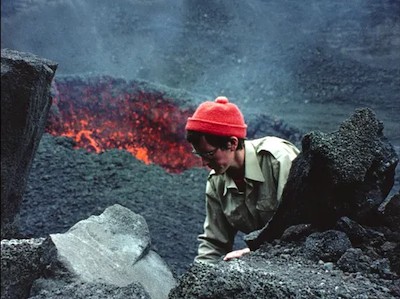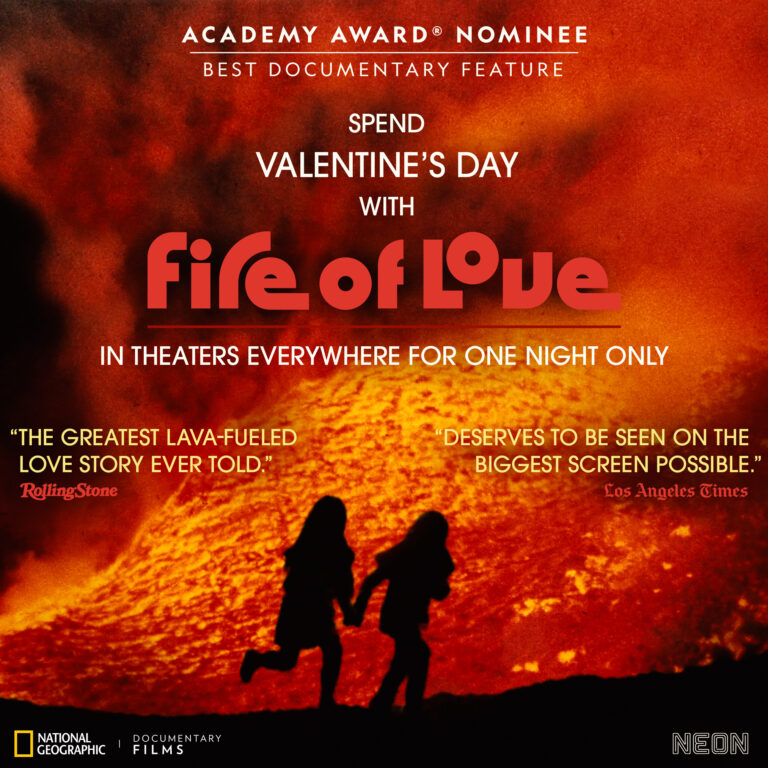Fire of Love – Snapshot
Fire of Love is a film about two geologists (Katia and Maurice Krafft) who spend an exciting marriage exploring volcanoes. They are responsible for some of the most spectacular and thrilling snapshots and videos of volcanic eruptions ever made. And they died doing what they loved. Despite the potential of a moving story, the film gives more insight into their love of volcanoes than of each other. (3*)
Where to Watch:
Stream: Hulu/Disney
Rent: Prime/Apple/Vudu/Google/YouTube ($4)
Fire of Love – The Oscar Buzz
Oscar Nominations:
Documentary Feature Film
Fire of Love received a single nomination for Documentary Feature Film, putting it in our “special interest” list. (One of the co-writers for Fire of Love , Shane Boris, was also a co-producer of this year’s documentary winner, Navalny.)
Fire of Love – The Movie’s Family Tree
The Following Movies Share Talent with This One (and if you like these films, you might like this one):
(None I could find!)
I couldn’t find any shared work among the talent on this documentary. Sara Dosa, the director of Fire of Love is a young filmmaker who was also a co-producer on an earlier Oscar-nominated documentary Edge of Democracy. She was not part of the creative staff on that movie.
It is also important to note that this not the only documentary that came out this year focusing on this exact same subject. Werner Herzog, a previous Oscar nominee for the 2007 documentary Encounters at the End of the World, released his own film, The Fire Within: A Requiem for Katia and Maurice Krafft, four months before Fire of Love. Viewer ratings for Herzog’s film are comparable to those for Fire of Love. One could easily ask why Dosa’s film was picked over the better known Herzog’s for a documentary nomination.
Fire of Love – What Others Think
Fire of Love is not at the top of anyone’s list. In fact, it pretty much falls into the middle of the pack compared to either the other four documentaries, all fifteen special interest films, or all 39 Oscar-nominated movies. And it doesn’t make a whole lot of difference whether you are talking about the viewing public or critics (although critics tend to rank documentaries a little higher than other films!)
Critical comments were generally positive, although not always enthusiastic. Nick Allen (RogerEbert) says “This has to be one of the most heartwarming movies about scientists ever made, especially as it always honors the red-hot nature in their shared passion.” Violet Luca (Sight&Sound) notes that the film “pairs spectacular archive footage with an unsatisfying narrative.” And later in her review “It attempts – and fails – to make the quotidian and inevitable dreamy.” On the other hand, A.O. Scott (New York Times) gave the film a Critics Pick arguing “They risked their lives to do this…, and the movie argues that their sacrifice wasn’t in vain. More than that, it preserves their work and their idiosyncratic unforgettable human presence.” (It would be instructive to see what the same critics would say about the Herzog film.)
Fire of Love – Special Mention
Documentary Films – Two and a half years ago, I wrote an essay comparing the five documentaries nominated in 2021. Before the awards were announced, I reviewed each of them, compared them and announced which film I thought was best and which film I thought would win the Oscar. As I predicted, My Octopus Teacher, won the Oscar that year and was also my favorite.
But what I wanted to refer to in that essay (2021 Documentary Movies) were the criteria I itemized for evaluating a documentary, which is a different kind of movie from what we normally review, or even watch. Documentaries, ostensibly, are presenting facts about real people and/or events. Of course there is a perspective the filmmakers are trying to communicate and that has to be part of the evaluation. But at least at the outset, a documentary is supposed to be true to reality, as opposed to other films which admit and relish the portrayal of fiction.
So, how do you evaluate a non-fiction/documentary film? In my previous essay, I outlined four basic considerations:
1. The message of the film and how well it confirms or “confronts strongly held feelings, beliefs and understandings.” Our own sociopolitical opinions, and even general world view, will definitely color our receptivity to a documentary’s message.
2. The craftsmanship of the moviemaking, i.e. how well is it put together. Usually this involves the same criteria we use for fictional films, although the subject matter may add or detract options available to the filmmaker.
3. The film must be honest. There must not be manipulation and the filmmaker must be clear on their message. (In an earlier review this year of a fictional film, I referred to this as “integrity”.)
4. The filmmaker must show effort in exploring their topic. I particularly like documentaries that take a “really long view” exploring the topic over a large time span.
We will return to these criteria below.
Mount Unzen – is a group of active volcanoes on Japan’s southernmost island. It is considered to be in the class of stratovolcanoes, as defined by many volcanologists, or as a “gray” volcano in the Krafft classification scheme. Regardless, of the names, it exists on the border of two merging tectonic plates and, as such, is capable of periodic and catastrophic eruptions. Similar volcanoes include Krakatoa (1883), Vesuvius (79), Mount St. Helens (1980), and Mount Pinatubo (1991). Mount Unzen erupted violently in 1991 (shortly before Pinatubo) and killed 43 people. The film is dedicated to those killed by the volcano. The deaths included Katia and Maurice Krafft, the subjects of this film.
Fire of Love – Michael’s Moments
Fire of Love is the first of this year’s documentary films I’ve reviewed. And I thought it might be useful to employ the four criteria I discussed in my essay from two and a half years ago, which I summarized above.
Level of Effort/The Long View – The more effort the filmmaker has made in a film usually rewards the viewer with a better movie. And we cannot fault Dosa’s efforts on this film. She went through something like twenty years worth of “deep archives” that the Kraffts had recorded including journals, still photographs, and videos and from that collection Dosa shaped remarkable closeups of exploding volcanoes, most of them worthy of a National Geographic magazine layout. Going back that far and ranging wide over their amassed material was a commendable amount of work.
Level of Craftsmanship – The filmmakers are young, but, especially with the help of the Kraffts stunning archival footage, they have been able to put together a coherent and frequently beautiful set of images. For more difficult geological concepts, they relied on animation to illustrate the principles, rather than just state them. The filmmakers intermix intense closeups of molten lava, with distant shots of massive explosions giving multiple perspectives on their subjects.
Honesty/Integrity – The viewer must never feel manipulated or insulted in this film. Dosa and her crew get high marks for being direct in their approach to the material. I did get a little annoyed at the constant breath-filled narrator, Miranda July. At times her narration seemed a bit melodramatic. But I think this is a relatively minor complaint.
The Message – And this is where the film runs into trouble. As stated a couple of times in the movie, this film is about a “love triangle” between Maurice, Katia, and volcanoes. Two sides of that triangle – the Kraffts love for volcanoes – is admirably illustrated. People do not approach death so closely unless they are madly and deeply in love with their subject. The film uses evidence from the Kraffts own records to not only illustrate how much they cared for their work, but also for how much there is to convey to the viewer about how these volcanoes function. They were scientists and the film makes that point well.
One of the most interesting concepts that I got out of the film was the distinction, made by the Kraffts themselves, between red and gray volcanoes. If you can see red, the volcano isn’t likely to hurt you – Maurice even sticks his boot into a lava flow and it temporarily catches fire. But a gray volcano is the kind that explodes with violent force – they are the killer volcanoes.
But what about that third leg of the triangle – the relationship between Maurice and Katia? That side of the love triangle is strangely undeveloped, especially since the film wants to consider that the central axis – the film is called “Fire of Love”, not “Love of Fire”. Yes, there is several minutes, around the ten minute mark, involving two coffee cups which shift positions and, somehow, this scene is supposed to illustrate how they fell in love at a coffee house. The narrator, in her breathy monologue, does inform us that there are no records of their budding romance. “As in love, there are mysteries.”
But if there is love between Katia and Maurice, it is really difficult to see. At one point in a supposed display of affection, Maurice throws a lava rock at Katia’s helmeted head! But nowhere in the movie do we ever see them kiss, hug, or even hold hands. Now “lack of evidence” is not “evidence of lack” – in today’s world, for a couple to stay together, and work together, as long as they did suggests that their relationship was solid. But the volcanic visuals were much more erotic, sensual, and passionate than anything we saw between them.
And that gets to the central problem with Fire of Love : the filmmakers lacked the visual or even anecdotal evidence of the central theme of their movie. Surrounded by lush and evocative volcanic images that easily suggest an organic or even sexual nature, the relationship portrayed between the Kraffts was, well, scientific. The filmmakers had a belief about a particular message they wanted to communicate but they just didn’t have the evidence to support it.
The problem with Fire of Love is that Dosa’s reach exceeded her grasp – she wanted to convey a three-way love triangle, but she only had support for two of the legs. She should have chosen a different message. Perhaps simply emphasizing how much her subjects loved volcanoes would have also given us some implied insight into their own love. But by explicitly stating a thesis and then not being able to show it, she weakened her case, and the film’s reason for being. (3*)


